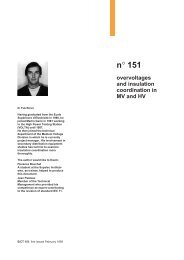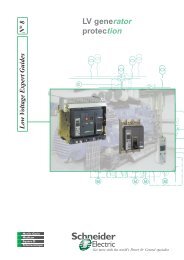sepam 20 user manual - Schneider Electric
sepam 20 user manual - Schneider Electric
sepam 20 user manual - Schneider Electric
Create successful ePaper yourself
Turn your PDF publications into a flip-book with our unique Google optimized e-Paper software.
Modbus communication Commissioning and diagnosis<br />
Link activity LED<br />
The ACE interface link activity LEDs are activated by<br />
variations in the signal on the Modbus network. When<br />
the supervisor communicates with Sepam (during<br />
transmission or reception), these LEDs flash.<br />
After wiring, check the information given by the link<br />
activity LEDs when the supervisor operates.<br />
Note: Flashing indicates that there is traffic passing to or from<br />
Sepam; it does not mean that the exchanges are valid.<br />
Functional test<br />
If there is any doubt about correct operation of the link:<br />
b run read/write cycles in the test zone<br />
b use Modbus diagnosis function 8 (sub-code 0, echo<br />
mode).<br />
The Modbus frames below, transmitted or received by a<br />
supervisor, are an example of a test performed when<br />
communication is set up.<br />
Test zone<br />
Read<br />
Transmission 01 03 0C00 0002 C75B<br />
Reception<br />
Write<br />
01 03 04 0000 0000 FA33<br />
Transmission 01 10 0C00 0001 02 1234 6727<br />
Reception<br />
Read<br />
01 10 0C00 0001 0299<br />
Transmission 01 03 0C00 0001 875A<br />
Reception 01 03 02 1234 B533<br />
Function 8 - Modbus diagnosis, echo mode<br />
Transmission 01 08 0000 1234 ED7C<br />
Reception 01 08 0000 1234 ED7C<br />
Even in echo mode, Sepam recalculates and checks<br />
the CRC sent by the master:<br />
b If the CRC received is valid, Sepam replies<br />
b If the CRC received is invalid, Sepam does not reply.<br />
PCRED301005EN - 06/<strong>20</strong>08<br />
Modbus diagnosis counters<br />
Counter definition<br />
Sepam manages the Modbus diagnosis counters. These are:<br />
b CPT1: Number of valid frames received, whether the slave is involved or not<br />
b CPT2: Number of frames received with a CRC error or physical error (frames with<br />
more than 255 bytes, frames received with at least one parity, overrun, framing or<br />
line-break error)<br />
b CPT3: Number of exception responses generated (even if not transmitted, due to<br />
receipt of a broadcast request)<br />
b CPT4: Number of frames specifically addressed to the station (excluding<br />
broadcasting)<br />
b CPT5: Number of valid broadcast frames received<br />
b CPT6: Not significant<br />
b CPT7: Not significant<br />
b CPT8: Number of frames received with at least one character having a physical<br />
error (parity, overrun, framing or line break)<br />
b CPT9: Number of valid requests received and correctly executed.<br />
Counter reset<br />
The counters are reset to 0:<br />
b when they reach the maximum value FFFFh (65535)<br />
b when they are reset by a Modbus command (function 8)<br />
b when Sepam auxiliary power is lost<br />
b when communication parameters are modified.<br />
Using the counters<br />
Modbus diagnosis counters help to detect and resolve communication problems.<br />
They can be accessed by the dedicated read functions (Modbus protocol functions 8<br />
and 11).<br />
CPT2 and CPT9 counters can be displayed on SFT2841<br />
("Sepam Diagnosis" screen).<br />
An incorrect speed (or parity) increments CPT2.<br />
Non-reception is signaled by the lack of change on CPT9.<br />
Operating anomalies<br />
It is advisable to connect the Sepam units to the Modbus network one by one.<br />
Make sure that the supervisor is sending frames to the relevant Sepam by checking<br />
the activity on the RS 232 - RS 485 converter or the fiber-optic converter if there is<br />
one, and on the ACE module.<br />
RS 485 network<br />
b check the wiring on each ACE module<br />
b check the tightness of the screw terminals on each ACE module<br />
b check the connection of the CCA612 cord linking the ACE module to the Sepam<br />
base unit<br />
b check that polarization is only at one point and that impedance matching is at both<br />
ends of the RS 485 network<br />
b check the auxiliary power supply connection to the ACE969TP-2<br />
b check that the ACE909-2 or ACE919 converter used is connected, powered and<br />
set up correctly.<br />
Fiber-optic network<br />
b check the connections on the ACE module<br />
b check the connection of the CCA612 cord linking the ACE module to the Sepam<br />
base unit<br />
b check the auxiliary power supply connection to the ACE969FO-2<br />
b check that the converter or fiber-optic star used is connected, powered and set up<br />
correctly<br />
b for a fiber-optic ring, check that the Modbus master can handle the echo of its<br />
requests correctly.<br />
In all cases<br />
b check all the ACE configuration parameters on SFT2841<br />
b check the CPT2 and CPT9 diagnostic counters on the SFT2841 ("Sepam<br />
Diagnosis" screen).<br />
5/7<br />
5

















